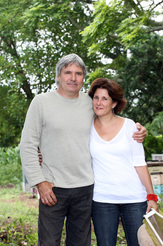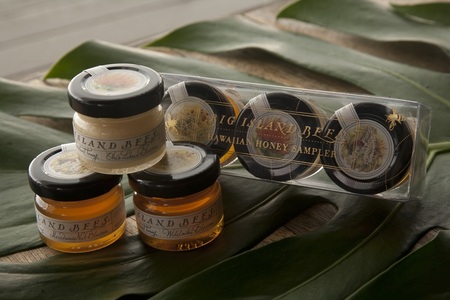The Buzz About Big Island Bees

(This article appeared in the April 2013 sustainability issue of Pacific Edge Magazine.)
by Jacob Kamhis
Ask a Big Island beekeeper as to the nature of the competition and the response you'll probably hear is, "Mother Nature."
Big Island Bees, a multi-generational beekeeping business in Captain Cook, remains as busy as the industrious insects it manages at a time when much of the island's feral bees has been lost to the varroa mite and hive beetle.
For years, honey has been a risky business around the world. Today, Big Island Bees faces the same daunting parasite challenges in a tropical area once considered clean for beekeeping. On the Big Island, the sweet substance still comes from the nectar of blossoms from the ohi'a lehua tree, the wilelaiki (Christmasberry) and macadamia nut tree. Honey from ohi'a lehua and wilelaiki are certified organic.
Garnett Puett and Whendi Grad, husband and wife, made the company fit to survive by adapting and working through the new environmental threats they face. They are a match in life and business.
Garnett grew up in a Georgia family of beekeepers and started handling bees at the age of five. His family moved to the Big Island and took over a relative's bee operation when he was in high school.
Garnett worked on producing and shipping honey to local food companies and offshore packers. When price margins dropped while operating costs grew, another threat to business, Whendi developed the value-added (retail) side of the operation. "I never thought I'd be into bees," she said. "But when you live with someone, they become part of your life."
Whendi always enjoyed cooking and began testing honey in what she made at home. Her trials evolved in the successful packaging and marketing arm of the business. Big Island Bees products sell at Costco, Whole Foods, R. Field Wine Company and island coffee shops.
When the last of their two children left for college last October, Whendi broadened beekeeping education and outreach in the community by setting up a honey museum. Tourists and residents visit the museum to taste, sense and check out the honey along with derivative wax products like pill coatings, surfboard wax, furniture polish, salves, lip balm and candles.
What's next for Big Island Bees when dealing with the ever-changing environmental challenges?
Garnett will have to "relearn" how to manage bees while Whendi tests and markets new honey products.
First, they'll start off in small quantities, according to Whendi, and then check for consumer reaction. If people are interested and reach for it, they expand the product line, which is sure to continue the buzz.
by Jacob Kamhis
Ask a Big Island beekeeper as to the nature of the competition and the response you'll probably hear is, "Mother Nature."
Big Island Bees, a multi-generational beekeeping business in Captain Cook, remains as busy as the industrious insects it manages at a time when much of the island's feral bees has been lost to the varroa mite and hive beetle.
For years, honey has been a risky business around the world. Today, Big Island Bees faces the same daunting parasite challenges in a tropical area once considered clean for beekeeping. On the Big Island, the sweet substance still comes from the nectar of blossoms from the ohi'a lehua tree, the wilelaiki (Christmasberry) and macadamia nut tree. Honey from ohi'a lehua and wilelaiki are certified organic.
Garnett Puett and Whendi Grad, husband and wife, made the company fit to survive by adapting and working through the new environmental threats they face. They are a match in life and business.
Garnett grew up in a Georgia family of beekeepers and started handling bees at the age of five. His family moved to the Big Island and took over a relative's bee operation when he was in high school.
Garnett worked on producing and shipping honey to local food companies and offshore packers. When price margins dropped while operating costs grew, another threat to business, Whendi developed the value-added (retail) side of the operation. "I never thought I'd be into bees," she said. "But when you live with someone, they become part of your life."
Whendi always enjoyed cooking and began testing honey in what she made at home. Her trials evolved in the successful packaging and marketing arm of the business. Big Island Bees products sell at Costco, Whole Foods, R. Field Wine Company and island coffee shops.
When the last of their two children left for college last October, Whendi broadened beekeeping education and outreach in the community by setting up a honey museum. Tourists and residents visit the museum to taste, sense and check out the honey along with derivative wax products like pill coatings, surfboard wax, furniture polish, salves, lip balm and candles.
What's next for Big Island Bees when dealing with the ever-changing environmental challenges?
Garnett will have to "relearn" how to manage bees while Whendi tests and markets new honey products.
First, they'll start off in small quantities, according to Whendi, and then check for consumer reaction. If people are interested and reach for it, they expand the product line, which is sure to continue the buzz.

